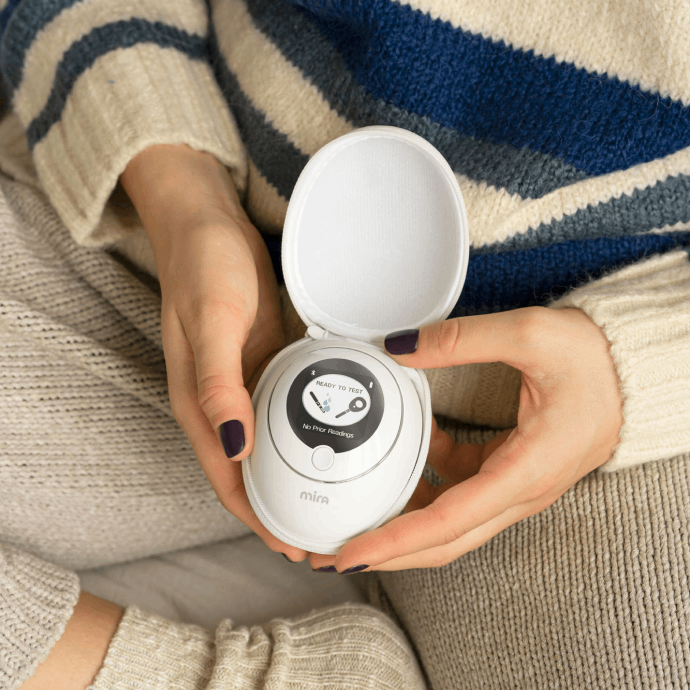"After 7 Months of Fertility Treatments, I got pregnant (naturally) in just 1 Month using Mira"
This describes a Mira customer’s personal experience and/or was sourced from a review or interview. Mira cannot guarantee the same results for everyone. Results will depend on each individual’s health conditions. Mira is not intended to diagnose or treat any diseases. Please consult with your doctor.

After trying naturally and then going through multiple rounds of fertility treatments, Patricia and her husband were successful in their first month using Mira! Read their story to see how Mira helped Patricia track her cycle and give conception the best effort possible.
When you’re young and relatively healthy you never expect to have problems trying for a baby. In fact, you’ve spent so long making sure that didn’t happen that it can be quite shocking when you decide to start trying and run into complications. So when Patricia and her husband, both healthy individuals in their mid-twenties, weren’t having any luck after several months they knew something was off.
“Just keep trying”
Knowing when you ovulate is key to getting pregnant so Patricia started checking to see when she ovulated with ClearBlue ovulation kits. Two months and many tests later, Patricia still wasn’t able to identify when she was ovulating, but chalked it up to inexperience and not really knowing what to look for. So she educated herself by meeting with a primary care provider and learning about her cycle, but that meeting left her less than satisfied.
Advice like “just keep trying” or “try having sex like 18 year olds” certainly sounded like fun, but it wasn’t exactly the medical advice Patricia was searching for. In a desperate attempt to implement the provider’s advice, the couple booked a baby-making weekend in Las Vegas during what Patricia thought would be her ovulation window. But even “drinking and relaxing” like their provider suggested wasn’t the answer and not only was Patricia not pregnant, but she still hadn’t been able to confirm ovulation.
Fertility procedures
Frustrated and confused, Patricia started looking into studies and research on irregular cycles and ovulation. After stumbling across information on polycystic ovarian syndrome (PCOS) a light went off and she made an appointment with another provider to investigate the issue. A thorough work-up later, Patricia was diagnosed with PCOS and it was discovered she was only ovulating 1-4 times a year! She was prescribed a drug known to stimulate ovulation in those with PCOS, Metformin, and told to keep trying. The couple gave it two more months of trying naturally before deciding to increase their chances with intrauterine insemination (IUI).
IUI can be performed with or without drugs, but in Patricia’s case doctor’s knew she would need help to force ovulation and increase her chances of success. Doctors tried a combination of Letrozole and Ovidrel, common fertility drugs used to help stimulate ovulation with IUI procedures, but after 4 rounds Patricia still wasn’t pregnant. Frustrated but not ready to give up, they switched their efforts to hormone stimulated timed intercourse with Gonal F and Ovidrel. But after two unsuccessful rounds they knew their next step was IVF, an expensive and emotionally consuming experience that doesn’t guarantee success. They decided to take a break to give them time to weigh their options before taking such an expensive leap.

Trying other fertility products
Before they even began trying, naturally or otherwise, Patricia had experimented with other fertility products to help pinpoint when she was ovulating. She’d had no luck with OPKs but had been using a wearable ovulation tracker, the Ava bracelet, to also predict ovulation. Her research on irregular cycles, and ultimate PCOS diagnosis, decreased her confidence in the bracelet. The lack of effective data made it all but unusable for Patricia and her irregular cycles so eventually she stopped using it. In her PCOS research she stumbled across Mira, and although she didn’t have much hope after using the Ava bracelet, she figured it couldn’t hurt.
After months of trying to understand her cycle and what was happening with her body throughout the month, she finally found something that gave her hope. She still struggled to pinpoint exactly when she was ovulating, but Mira helped her identify a fertile window for the couple to take advantage of to increase their chances of conceiving.
Through testing and reading the instructional data on Mira’s website, Patricia was able to better understand what was happening with her body throughout the month. In fact, within her first month of using the device she was able to identify when she was at peak ovulation – for the first time! The couple took advantage of that information and made sure they didn’t miss their baby-making window.
Weeks later, Patricia decided to take a pregnancy test on a whim. To her surprise it was positive! After all of the adversity they had faced, and the challenge of figuring out ovulation, she was finally pregnant.
Though they faced adversity, Patricia and her husband never gave up. With a baby girl due in September 2022, the couple is over the moon and ready for the challenges parenthood will bring.
Life after Mira
Being diagnosed with PCOS can certainly be frustrating, but it wasn’t the end of trying to conceive for Patricia and her husband. Mira helped Patricia understand her cycle, even with irregular hormones, and helped her manage her expectations while also giving conception her best efforts. This is just the start for Patricia though, she plans to continue using the device when trying for all of her future children.
How Mira Works with PCOS
Unlike other methods for ovulation prediction, Mira works with your body. Our system learns your cycle to provide you with ovulation predictions based on your unique hormones. Click here to learn more about how Mira helps women with PCOS that are trying to conceive.



